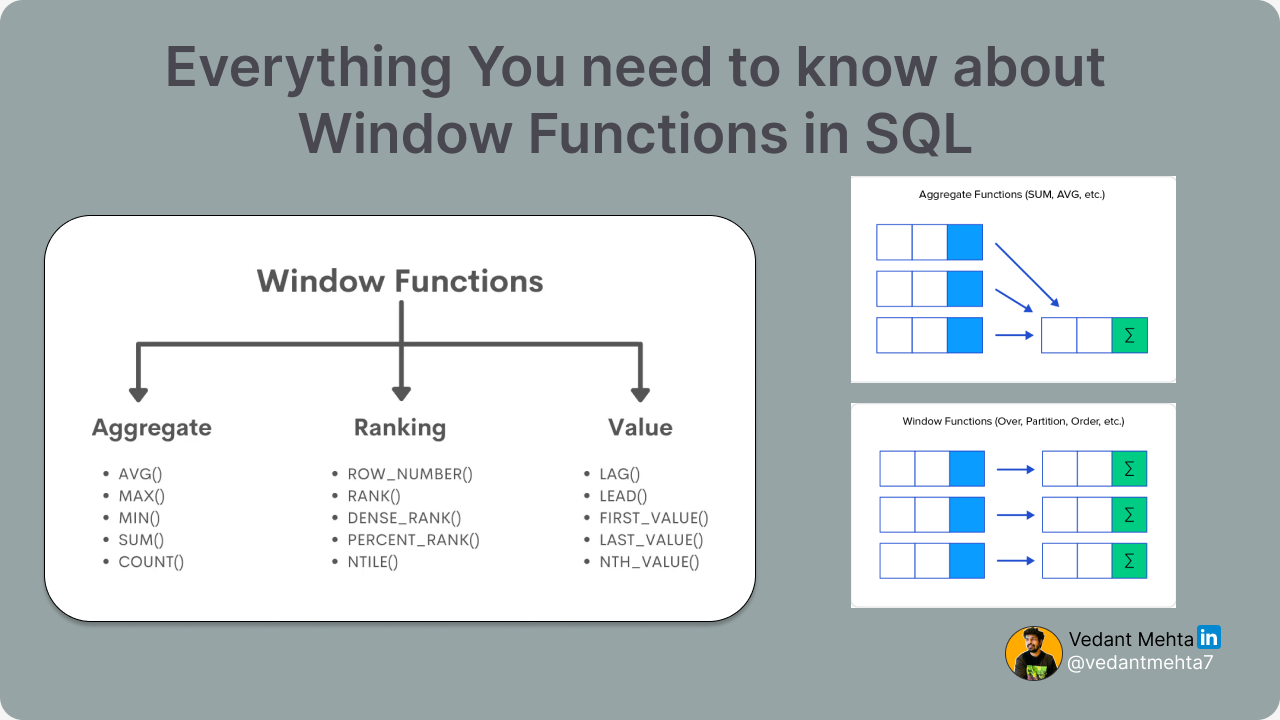Introduction
SQL Window Functions are powerful tools that allow you to perform calculations across a set of table rows related to the current row without collapsing the result into a single group. Unlike aggregate functions, which summarize data into a single row per group, window functions retain individual rows while applying calculations over a “window” of rows.
This guide covers:
- Different types of window functions
PARTITION BYandORDER BY- Real-world use cases
What are Window Functions?
A window function performs a calculation across a subset (window) of rows related to the current row. It uses the OVER() clause, which defines how the window is partitioned and ordered.
Syntax:
SELECT column_name,
window_function() OVER (
PARTITION BY column_to_partition
ORDER BY column_to_order
) AS alias
FROM table_name;
Types of Window Functions and When to Use Them
1. ROW_NUMBER() - Assigns a unique sequential number to each row.
When to Use:
- When you need a unique rank for each row in an ordered dataset.
- To remove duplicates while keeping the first occurrence.
Example: Get the first purchase of each customer
SELECT customer_id, order_id, order_date,
ROW_NUMBER() OVER (PARTITION BY customer_id ORDER BY order_date) AS order_rank
FROM orders;
2. RANK() - Assigns a rank to each row, with gaps when there are ties.
When to Use:
- When you want to rank items but allow tied values to share the same rank.
Example: Rank products by total sales
SELECT product_id, SUM(quantity) AS total_sold,
RANK() OVER (ORDER BY SUM(quantity) DESC) AS sales_rank
FROM sales
GROUP BY product_id;
3. DENSE_RANK() - Similar to RANK(), but without gaps.
When to Use:
- When ranking should be sequential even if values are the same.
Example: Rank employees by salary
SELECT employee_id, department, salary,
DENSE_RANK() OVER (PARTITION BY department ORDER BY salary DESC) AS salary_rank
FROM employees;
4. NTILE(N) - Divides rows into N equal buckets.
When to Use:
- When you need to split data into quartiles, deciles, or percentiles.
Example: Divide students into quartiles based on marks
SELECT student_id, marks,
NTILE(4) OVER (ORDER BY marks DESC) AS quartile
FROM students;
5. LAG() - Fetches the previous row’s value.
When to Use:
- When you need to compare a value with the previous row’s value.
Example: Compare this month’s vs. last month’s sales
SELECT month, total_sales,
LAG(total_sales, 1) OVER (ORDER BY month) AS previous_month_sales,
total_sales - LAG(total_sales, 1) OVER (ORDER BY month) AS sales_change
FROM monthly_sales;
6. LEAD() - Fetches the next row’s value.
When to Use:
- When you want to compare a value with the next row’s value.
Example: Find the difference between an employee’s salary and the next highest salary
SELECT employee_id, salary,
LEAD(salary) OVER (ORDER BY salary DESC) AS next_salary,
LEAD(salary) OVER (ORDER BY salary DESC) - salary AS salary_difference
FROM employees;
7. SUM() OVER() & AVG() OVER() - Running totals and moving averages.
When to Use:
SUM() OVER()for cumulative totals.AVG() OVER()for moving averages.
Example: Calculate cumulative sales per region
SELECT region, month, total_sales,
SUM(total_sales) OVER (PARTITION BY region ORDER BY month) AS cumulative_sales
FROM regional_sales;
Summary: Which Function to Use When?
| Use Case | Function to Use |
|---|---|
| Assigning unique numbers | ROW_NUMBER() |
| Ranking with gaps | RANK() |
| Ranking without gaps | DENSE_RANK() |
| Dividing data into N groups | NTILE(N) |
| Comparing previous values | LAG() |
| Comparing next values | LEAD() |
| Cumulative total | SUM() OVER() |
| Moving average | AVG() OVER() |
Image credit: Vedant Mehta on LinkedIn
By using SQL Window Functions, you can efficiently analyze trends, rankings, and comparisons in datasets. Start experimenting with these functions to improve your SQL queries!
